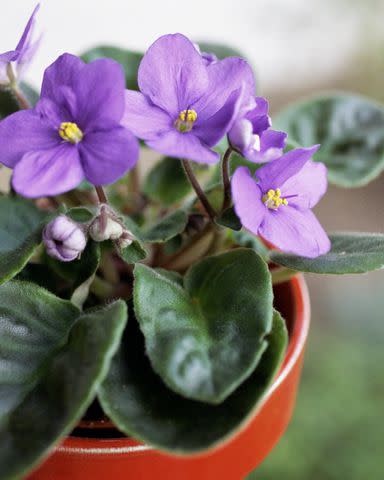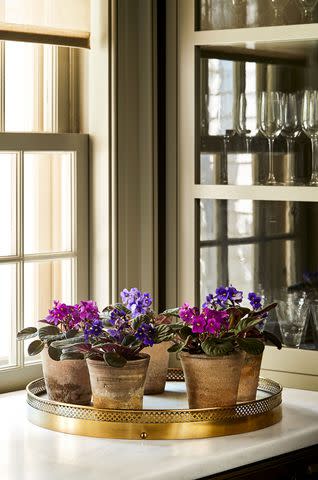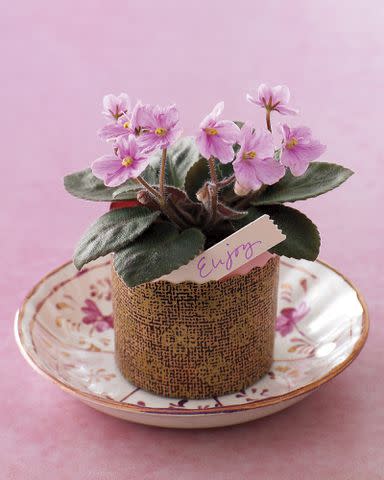How to Care for African Violets So They Thrive for Decades to Come
These pretty potted plants last longer than you might think.
African violets are hardy, beautiful plants that add vibrant color and old-world charm to your houseplant collection. Native to tropical Tanzania and southeastern Kenya, they prefer warmer climates—in most of the United States, African violets are considered an indoor-only plant. But what an indoor plant to have! "They are great as gifts to build memories around, can travel from house to house, and are beautiful to pass between friends and family," says Ryan McEnaney, a fifth-generation gardener from Bailey Nursery. Not only that, they can live upwards of 50 years with proper care.
Ahead, we tapped McEnaney and other gardening experts for their tips on caring for African violets, from potting and growing to propagating.
Meet Our Expert
Ryan McEnaney, a fifth-generation gardener from Bailey Nursery, where he is also the public relations and communications specialist
Samantha Foxx, a farmer and beekeeper at Mother's Finest Urban Farm
Brian Parker, senior merchant for Live Goods, Home Depot
Related: How to Choose the Right Size Pots for Your Plants
How to Pot African Violets

McEnaney says to find a small pot about the same diameter (or a bit smaller) as the existing plant so that it has some room to grow. "They don't mind getting a little root bound in the pot, so don't worry about overcrowding yet," he adds. McEnaney urges home gardeners to make sure that the pot has a drainage hole in the bottom so the soil doesn't get soggy. "The flowers don't like wet feet, meaning the roots are sitting in wet soil so that drainage hole will allow the soil to stay evenly damp and well-drained."
Samantha Foxx, farmer beekeeper of Mother's Finest Urban Farm, adds that she likes to plant them in well-draining soil and a porous pot. More specifically, they need soil with plenty of vermiculite and perlite in its mixture for moisture control to help the violet thrive and look more vibrant, says Brian Parker, senior merchant for Live Goods, Home Depot.
Due to their long lifespan, repotting your African violets is a must. "As the plants grow, they can be repotted into larger pots so that they don't get too root-bound," says McEnaney. "Once your African violet has doubled or tripled the size of your pot and the leaves are starting to wilt a bit, it's time to make the move.
Care Requirements for African Violets

Light
When it comes to growing the colorful plant indoors, it's best to place them in a part of the home that receives bright indirect light. "In the winter months, windows that face west or south are best, and in the summer months, look for windows that face north or east to give your African violets the light they need." He warns that if there are no trees to filter the light, it's important to move the pots back a bit as the direct sunlight can burn the leaves.
Temperature
And temperature plays an important role, according to McEnaney; they thrive with an indoor temperature between 65 and 75 degrees Fahrienheit. "Anything below 60 degrees will not only stunt the growth but cause the leaves to be thin and brittle," he says.
Fertilizer
As for the best type of soil, liquid fertilizer is the way to go, says Parker. "African violets require a specific liquid fertilizer or a blooming house plant fertilizer with a higher middle number (Phosphorus), which promotes blooming every four to six weeks in spring, summer, and fall," says Parker.
Another way to keep your plant looking its best? Deadheading. "As for deadheading your African violets, it's fine to remove drooping blooms, as this will encourage more flowers to develop over time," says McEnaney.
Watering African Violets
There is no set schedule for watering, says Parker. "The best way to determine if you need to water African violets is to feel the top of the soil. If the soil is dry to the touch, then it needs to be watered." He suggests using room-temperature water.
As far as technique goes, he says to always water from underneath by placing the violet in a saucer. Fill the saucer well above the drainage holes at the bottom of the pot. "It is important to avoid getting the leaves wet," he says. "Once leaf damage occurs, the plant may not recover." He recommends letting the plant sit for about an hour and then pour the water out.
"For best results, African violets should be allowed to dry out between each watering," he says. But overwatering can lead to killing the plant, so be sure to maintain a careful balance.
Propagating African Violets

African violets are very easy to propagate from leaf cuttings—and what's better than free new plants?!
"Start by simply pinching off a leaf with stem, plant stem in vermiculite or light soil mixture, water the soil, and cover with saran wrap type plastic," says Parker, adding to always plant in a light soil mixture. "Within weeks, the stem will develop new roots and will be ready for transfer to a 4-inch container."
"For a low maintenance option, consider a self-watering pot that allows you to water from the bottom and keep plants hydrated and healthy." Insert the cutting so that the leaf is anchored in the soil, and you'll begin to see small roots in about three weeks.
Read the original article on Martha Stewart.
